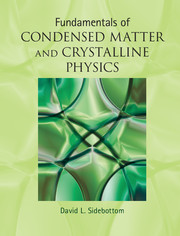 Fundamentals of Condensed Matter and Crystalline Physics
Fundamentals of Condensed Matter and Crystalline Physics 1 - Crystal structure
from Part I - Structure
Published online by Cambridge University Press: 05 August 2012
Summary
Introduction
We often think of crystals as the gemstones we give to a loved one, but most metals (e.g. copper, aluminum, iron) that we encounter daily are common crystals too. In this chapter, we will examine the structure of crystalline matter in which particles are arranged in a repeating pattern that extends over very long distances. This long-range order is formally described by identifying small local groupings of particles, known as a basis set, that are identically affixed to the sites of a regularly repeating space lattice. As it happens, most crystals found in nature assume one of a limited set of special space lattices known as Bravais lattices. These lattices are special by virtue of their unique symmetry properties wherein only discrete translations and rotations allow the lattice to appear unchanged. Chief among these Bravais lattices are the cubic and hexagonal lattice structures that appear most frequently in nature. We focus extra attention on both to provide a useful introduction to coordination properties and packing fractions.
Crystal lattice
Crystals have a decided advantage because of the inherent repeating pattern present in their structure. In an ideal (perfect) crystal, this repeating pattern extends indefinitely. However, for real crystals found in nature, the pattern is often interrupted by imperfections known as defects that can include vacancies, in which a single particle is missing, and dislocations in which the repeating pattern is offset. These defects are important for some crystal properties, but for now we restrict ourselves to only ideal structures. Besides, even in real crystals large regions containing substantial numbers of particles exist in which a perfectly repeating pattern is maintained.
- Type
- Chapter
- Information
- Fundamentals of Condensed Matter and Crystalline PhysicsAn Introduction for Students of Physics and Materials Science, pp. 3 - 19Publisher: Cambridge University PressPrint publication year: 2012


